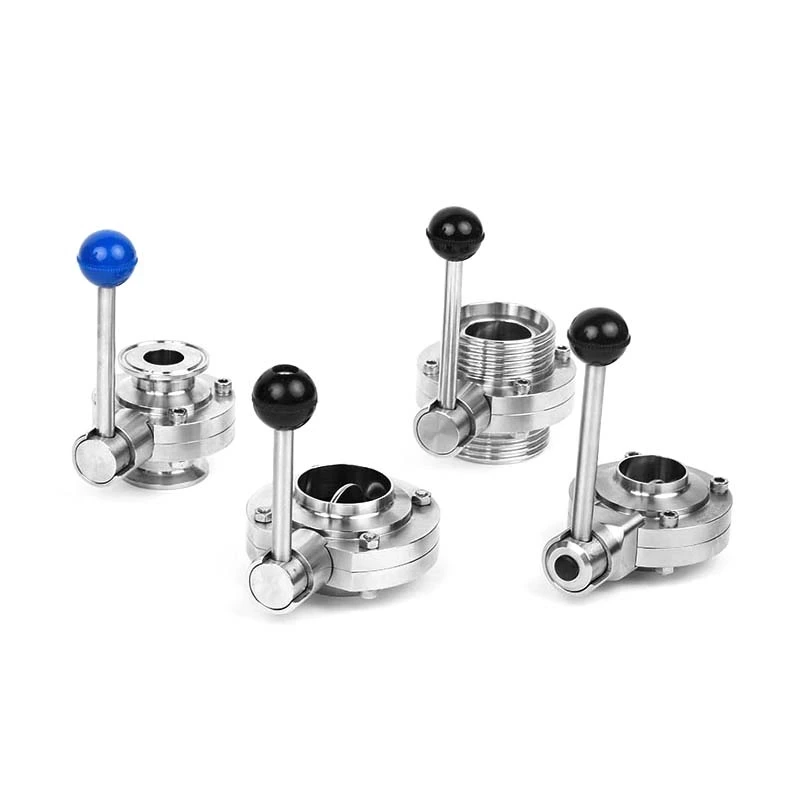Installation Requirements And Precautions For Stainless Steel Pneumatic Butterfly Valves
Sanitary Butterfly Valve is a commonly used control valve, which uses a pneumatic actuator as a drive device, and realizes the opening and closing of the valve by controlling the switch of the air source. Its valve body material is made of stainless steel, so it has the characteristics of corrosion resistance, high temperature resistance, and pressure resistance. It is installed on the upper part of the door or housing of a manual or electromechanical machine through a compressed air supply point. When the valve is working, the sleeve is gradually squeezed and closed at the midpoint of its length, cutting off the flow of the fluid. This contraction can be achieved in two ways: manual mechanical contraction by turning a steering wheel (such as a gate valve or a motor) or compressed air contraction. In both cases, the handle or motor will rotate a mechanical screw to operate the pipe clamp valve mechanism, which usually consists of two flat metal rods, one on the upper part of the sleeve and the other on the lower part of the sleeve. When the screw rotates, it pulls the two rods together and squeezes the closed sleeve as it moves.
Pneumatic stainless steel butterfly valves are widely used in pipe networks and equipment in water industry, water supply and drainage, heating and steam supply, water treatment, petrochemical industry, papermaking, smelting, food brewing, pharmaceutical and medical equipment, textile printing and dyeing, rubber machinery, organic and inorganic chemicals, chemical preparations and other industries. It not only has a simple structure, small size, light weight, low material consumption, small installation size, but also small driving torque, easy and quick operation, and can also have good flow regulation function and closing sealing characteristics.
Installation requirements of stainless steel pneumatic butterfly valves:
1. Pay attention to the direction of the medium fluid and the direction of the arrow when installing pneumatic butterfly valves
2. The rising stem valve of the pneumatic butterfly valve cannot be installed geographically to prevent the valve stem from rusting. In the trench with a cover plate, the valve should be installed and maintained and inspected and operated
3. When the pneumatic butterfly valve is installed in a horizontal pipeline, the valve stem should be vertically upward or tilted at a certain angle. The valve stem is not allowed to be installed downward
4. The valve connected with flanges and threads should be closed during installation. Install flange valves to ensure that the two ends of the flange are parallel and concentric to each other.
Precautions for using stainless steel pneumatic butterfly valves:
1. The relationship between the opening and flow of pneumatic butterfly valves is basically linear. If used to control flow, its flow characteristics are also closely related to the flow resistance of the piping. For example, if the valves installed on two pipelines have the same diameter and form, but the pipeline loss coefficients are different, the flow of the valves will also be very different.
2. If the valve is in a state of large throttling range, cavitation is prone to occur on the back of the valve plate, which may damage the valve. It is generally used outside 15°.
3. When the pneumatic butterfly valve is in a medium opening, the opening shape formed by the valve body and the front end of the butterfly plate is centered on the valve shaft, and the two sides form different states. The front end of the butterfly plate on one side moves in the direction of the water flow, and the other side moves in the direction of the water flow. Therefore, the valve body and the valve plate on one side form a nozzle-shaped opening, and the other side is similar to a throttling hole-shaped opening. The nozzle side has a much faster flow rate than the throttling side, and negative pressure will be generated under the valve on the throttling side, and the rubber seal will often fall off.
4. The operating torque of the pneumatic butterfly valve varies with the opening and opening and closing direction of the valve. For horizontal pneumatic butterfly valves, especially large-diameter valves, the torque generated by the difference in water head between the upper and lower ends of the valve shaft due to the water depth cannot be ignored. In addition, when an elbow is installed on the inlet side of the valve, a biased flow is formed, and the torque will increase. When the valve is in the middle opening, the operating mechanism needs to be self-locking due to the action of the water flow torque.
